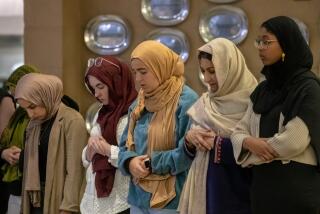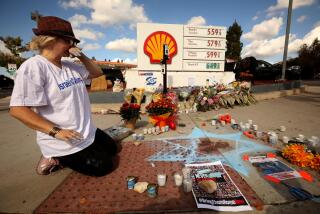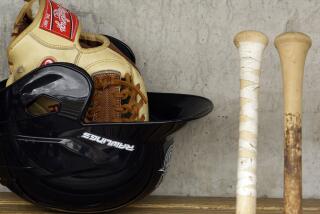New Mosque Prepares for Ramadan
GRANADA HILLS — As Muslims today begin a month of daytime fasting, a $2.2-million mosque--the first in Southern California to be built solely with local money--nears its long-delayed opening.
During Ramadan, the holiest month on the Islamic calendar, all able-bodied Muslims are expected to abstain from food, drink and sex from dawn to sunset as an act of spiritual self-discipline.
At mosques, the Koran, the sacred scripture of Islam, is recited in its entirety during the lunar month and special evening prayers are offered.
The Islamic Center of Northridge had hoped to begin those rites today at its new mosque in Granada Hills, but recent rains and high winds postponed final construction work and city inspections at the red-tile-roofed building overlooking the 118 Freeway. The leaders of the mosque still hope to open it with traditional Friday midday prayers next week.
The opening will mark another milestone for organized Islam’s steady growth in Southern California, which had 55 mosques in 1994 and nearly 75 today, according to Shakeel Syed, coordinator of the Islamic Shura Council of Southern California.
The new mosque--or masjid in Arabic--is only the third Islamic center in Southern California to be designed and built as a mosque, the others being located in converted buildings.
But the other two, San Diego’s Masjid Abu Bakr and the $8.5-million Masjid Omar Ibn Al-Khattab next to the USC campus, were constructed in the early 1990s with large donations from Muslims overseas.
“We took no foreign money,” said Masood Rana, immediate past president of the Islamic Center of Northridge, which will keep its original mosque, a converted house on Tampa Avenue, for additional prayer services and classes.
“The basic reason for raising our own funds was that people don’t attend a mosque if they don’t have a sense of ownership and participation in its building and in its maintenance,” Rana said. Most delays in construction since 1990 were due to dependence on volunteer technical expertise and the leadership’s pay-as-you-go policy.
U.S. Islamic leaders acknowledge that mosque attendance is not an ingrained habit, especially among immigrants from predominantly Islamic countries. Devout Muslims may fulfill their five-times-daily prayer obligations without visiting a mosque.
But motivated by the desire to reinforce and foster their religious values and provide religious education for their children, Muslims have formed makeshift mosques in homes, rented halls and renovated buildings until larger ambitions can be realized.
*
Ideally, Muslims prefer mosques to have the customary architecture and symbols of Islam, just as Christian churches want to display typical architectural symbols of Christianity such as steeples, bell towers and crosses.
Minarets and a dome adorn Los Angeles’ Masjid Omar Ibn Al-Khattab, where Friday prayers usually draw about 600 Muslims--more than half of them African Americans and the rest Indo-Pakistani, Ethiopian, Arabic, Malaysian and other ethnic Muslims, said Yahya Abdul-Rahman, who serves as an imam, or religious leader.
But when the Islamic Center of Northridge received city approval in 1990 to build a mosque on a narrow, 2.2-acre strip of land in Granada Hills, the permit came with what a zoning administrator called a record 44 restrictions, including limits on how many people may attend events in the first year and thereafter.
The permit was granted only after hearings that took neighbors concerns’ about plans for the mosque all the way to the City Council. In addition to neighborhood concerns about traffic, there was pressure on the Islamic Center to build a structure that would blend into the residential area around Rinaldi Street on the northern rim of the San Fernando Valley.
Islamic Center leaders in response presented city officials with architectural drawings showing a dome-less building with a Spanish tile roof and stucco walls, a common look in Southern California. The council accepted that--a decision publicly lamented by then-Mayor Tom Bradley, who accused the council of religious intolerance.
However, the city-imposed restrictions do not rule out a minaret for the new mosque, said Rana, who last month ended a two-year term as president of the mosque.
“We plan to put up a minaret near the front entrance during Phase 2 of our construction,” Rana said. Though in Islamic countries the tower is a mount from which the muezzin calls the faithful to prayer, the minaret in America “is significant for its symbolic nature--like a cross on a church,” he said.
The city prohibited a dome on the building. Rana said the new mosque instead has a skylight over the prayer hall.
“That’s all right,” he said, “because you wouldn’t see a dome from the freeway, whereas eastbound motorists would be able to see the minaret.”
Rana said one condition will be easy to meet: a prohibition on loudspeakers, bells, chimes and alcoholic beverages on the site. Bells and chimes are not typical for mosques and alcoholic drinks are prohibited in Islam.
For the first year of operation, city permits allow only 150 people to attend Friday prayer services in the main prayer hall--a high-ceilinged room that could accommodate more than 350 men on the ground floor and 50 or more women on a balcony level in the rear of the hall.
In addition to attendance restrictions, the permit limits total mosque membership to 250 people in the first year and a maximum of 400 thereafter. But Rana said the Islamic Center will appeal some of the limitations at year’s end.
“We want to comply with the conditions, but once the city sees [our] harmony with the rest of the neighborhood, we should not have a problem,” said Rana, a Porter Ranch resident and vice president of Van Nuys-based GeoSoils Inc.
The entrance to the new mosque on Encino Avenue faces an adult education school. One block away on Rinaldi Street is Hillcrest Christian School, an evangelical private school, as well as the former Hillcrest Christian Church.
*
The Rev. Dudley Rutherford, who was pastor of Hillcrest in 1990, before it merged with Shepherd of the Hills Church and moved to Porter Ranch, said his old congregation did not oppose the mosque’s right to build.
“It’s shockingly difficult for any religious congregation to get building permits, even for churches,” Rutherford said. “We were not part of the opposition--not because we agree with [their religious beliefs] but because we believe in the freedom of religion.”
Nonetheless, the lessons taught during Ramadan are similar to teachings of other religious traditions, says Hasan Hashmi, an imam with the Islamic Center of South Bay in Lomita, who once assisted with services at the Northridge center.
As in Judaism, Christianity and other major faiths, fasting teaches self-control over human desires and passions, Hashmi wrote in the Northridge center’s newsletter. The practice is a form of piety. “The fasting person . . . abstains from food, drink and other pleasures of life just for love of his creator, not to please other people,” Hashmi wrote.
Fasting also teaches a practical lesson in compassion for the sufferings of others, he said. “Nobody can know exactly the misery of hunger and thirst just by listening to the afflicted ones.”
More to Read
Sign up for Essential California
The most important California stories and recommendations in your inbox every morning.
You may occasionally receive promotional content from the Los Angeles Times.










